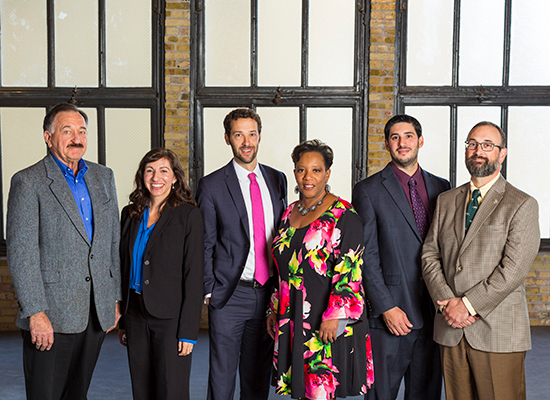
From left: Byll Hess, Cristina Bordé, Brian Potts, Hon. Valarie Hill, Nick DeSiato, and Seth Dizard are this year’s Wisconsin Legal Innovators.
Photos: Andy Manis
The path toward legal innovation often begins with “What if?” What if we could devise a way to make a certain task easier and less time-consuming? What if we could use a legal process in a different way to solve a new problem? What if we could make the justice system more equitable and accessible?
Such were the questions that sparked the creativity of this year’s legal innovators, selected in the State Bar of Wisconsin’s fourth annual “That’s a Fine Idea: Legal Innovation Wisconsin” initiative.
Jump to a Wisconsin Legal Innovator
“The idea is to showcase innovation in the legal community,” says Tom Watson, chair of the Innovation Subcommittee of the State Bar’s Communications Committee. “To us, innovation is a change in the way lawyers typically do things, or a new service or product offering, or a new way to deliver legal services. It runs the gamut.”
Legal innovation is happening around the state, Watson says, but often it goes unrecognized, sometimes even by the lawyers who themselves are devising new ideas. The State Bar’s innovations initiative brings those ideas into the spotlight.
What’s more, learning about others’ innovative ideas may inspire lawyers to create their own entrepreneurial approach to the delivery of legal services, Watson says. “Ultimately that’s better for lawyers and for their clients. Everybody wins.”
This year we honor five individual or team innovators, including a lifetime award winner. The search for 2018’s innovation award winners will run from April through June next year. Consider submitting your nominations, whether for yourself or someone else. To learn more, visit ThatsaFineIdea.com.
Lifetime Innovator William (Byll) Hess: Leading the Way in Adopting Technology
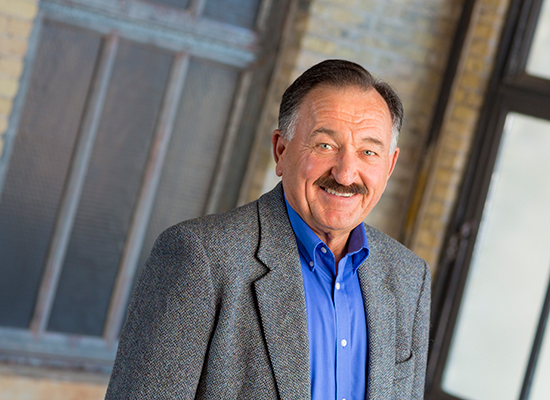
William (Byll) Hess probably got a few stares from passersby when they saw him walking around with one of the earliest cell phones. It was so big he had to carry it in its own shoulder bag. But it did enable him to be more accessible to his clients.
Back in the 1970s, William (Byll) Hess probably got a few stares from passersby when they saw him walking around with one of the earliest cell phones. It was so big he had to carry it in its own shoulder bag. But it did enable him to be more accessible to his clients.
That’s just one indication that Hess is one of those people who’s eager to try something new – and to help others figure out how to do the same. Those inclinations have earned him the State Bar’s Lifetime Legal Innovator award for 2017.
Throughout his 47-year law career, Hess has been on the lookout for technologies that make it possible to “run a law firm as a business so you can be more capable of providing quality legal services,” he says.
Along the way, he’s found kindred spirits among legal colleagues. One of those was fellow Wausau attorney and coworker Dick Trembath, who along with Hess began to explore new law office computer technology in the late 1970s.
Dianne Molvig is a frequent contributor to area and national publications.
They signed on as one of only three firms (one small, one medium, and one large) nationwide to join a beta test group for Computrac, a then-fledgling company in Richardson, Texas, that was developing law office computer technology.
“We were the small firm in the group,” Hess says. “We got a tremendous amount of software and hardware that we couldn’t have afforded otherwise. And we got to be part of their planning and development.”
Hess and Trembath instituted other innovations back then, too, such as expanding the role of legal secretaries so they could serve as legal assistants and hiring an office manager with business experience. “We were also developing a lot of checklists, practice systems, and forms – things that I found exciting, and Dick did, too,” Hess says.
In 1980, Hess’s firm bought a Hewlett-Packard “mini” computer. “The hard drive was the size of a mini refrigerator” with just 120MB of information. It required a terminal to use and cost $27,000. And in 1983, it was the HP 150 Butterfly, with a green touchscreen. “We’ve come back to the touchscreen again, now in vivid color,” Hess says.
Law office technology continued to expand, but by the 1990s many small and solo firms still couldn’t afford computers or online research services. And with many counties in Wisconsin defunding their law libraries, lawyers had no access to legal research. That’s when Hess and others at the Marathon County Bar Association set out to find a solution.
They struck a deal with LexisNexis® to pay a low monthly fee to provide online research services to county bar members. The courthouse provided a room to house a couple of computers.
“We figured we were getting $200,000 to $300,000 worth of research time for about $1,500 a month,” Hess reports. “It was a great idea.” That arrangement ended, however, a few years later, when Westlaw and LexisNexis jointly decided not to provide services at such low cost.
“We lost that service for our county bar,” Hess says, “but now there’s Fastcase®, which the State Bar offers as part of members’ dues. We were doing something similar for our county bar 20 years ago.”
One of Hess’s proudest accomplishments was helping to create the State Bar’s Law Office Management Assistance Program (LOMAP), now known as Practice411™. When George Burnett became State Bar president in 2003, one of his key goals was to find ways to enhance State Bar services to solo and small-firm lawyers. He appointed Hess to chair the committee to explore possibilities.
Burnett knew that creating some kind of solution would take longer than his one-year term as president. “Appointing a committee chair who was both diligent and committed and had the respect of those who succeeded me was essential,” Burnett says. Hess had that kind of respect, and he’d served on many State Bar committees, including the former Technology Committee.
“I agreed with George,” Hess says, “that there was a lack of services directed to solo and small firms, particularly in the area of practice management.” Hess was happy to take on the committee chair position to guide LOMAP’s creation. “I had worked for a long time on trying to introduce opportunities for solo or small-firm lawyers to become more technology savvy. Most of them could not afford to hire an IT specialist on their own, so we needed the services,” Hess says. The committee put together a long list of services that it felt solo and small-firm lawyers would benefit from. First and foremost was to create the position of a practice management advisor to be filled by a lawyer with a strong background in technology.
His various efforts to help solo and small-firm lawyers earned Hess the 2015 John Lederer Award, named for the late Oregon, Wis., attorney. You can count Lederer as another of Hess’s kindred spirits; the two served together on the State Bar’s Technology Committee. Both aspired to find ways to help solo and small-firm lawyers master the skills and technologies needed to build their practices.
Helping other lawyers just seems like the right thing to do, in Hess’s view. “I was the first in my family to go to college and the first to go beyond a bachelor’s degree,” he says. “I’ve always felt fortunate to have had those opportunities, and I just feel you have to give back.”
Cristina Bordé, Maria de Arteaga, Yvonne Geerts: Helping Wrongfully Convicted Latino Inmates
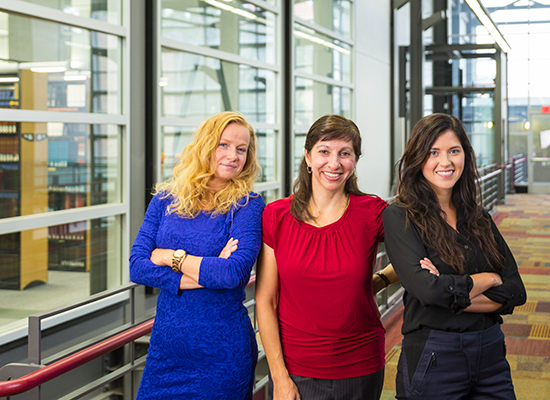
Yvonne Geerts, Cristina Bordé, and Maria de Arteaga noticed the exoneration rate for Latino inmates was disproportionately low compared to that for African American and non-Latino white inmates. Why was that? What could be done? Those questions spurred creation of the Wisconsin Latino Exoneration Program, an initiative of the Wisconsin Innocence Project at the U.W. Law School.
The number of wrongful-conviction exonerations in the United States hit a record annual high of 166 in 2016, bringing the current total to 2,101, according to the National Registry of Wrongful Convictions.
Cristina Bordé, a clinical instructor at the U.W. Law School, took a closer look at the data and saw a troubling statistic. “I noticed the number of Latino exonerees was low compared to the number of Latinos in prison,” she says.
Of total exonerees, 11 percent were Latino inmates, who made up 22 percent of the national prison population. That compared to African American inmates, who comprised 47 percent of exonerees and 38 percent of the prison population, and non-Latino white inmates, who accounted for 35 percent of exonerees and 40 percent of the prison population.
Why was the exoneration rate for Latino inmates so disproportionately low? And what could be done about it?
Those questions spurred Bordé to create the Wisconsin Latino Exoneration Program, which handles cases involving DNA evidence. Funding came through a two-year grant from the U.S. Department of Justice that enabled hiring full-time staff, including attorney Maria de Arteaga and intake specialist Yvonne Geerts, both of whom are bilingual. Bordé, also bilingual, supervises the program, which is an initiative of the Wisconsin Innocence Project.
After the official launch in June 2016, the first step was to reach out to Latino inmates statewide. Word about the new program spread via Spanish-language radio and television. Posters appeared in prison libraries. Direct mailings went out to all Wisconsin inmates identifying as Latino with the Wisconsin Department of Corrections. Those inmates each received a follow-up phone call from Geerts to answer any questions. Supervising lawyers and law students have since begun to work on cases.
For Latinos, wrongful convictions occur due to the usual factors: mistaken witness identifications, false or misleading forensic evidence, false accusations, false confessions, and official misconduct.
“But there are additional factors that are more likely to be present in the case of Latinos,” Bordé explains. For instance, witnesses might not want to come forward because of fear of deportation.
Language barriers are another pitfall. Police and court authorities will ask if a suspect or defendant speaks English. If the answer is yes, everyone assumes the person is fluent. But, Bordé points out, there are many levels of fluency.
“Many of our clients have learned enough English to get by,” she says. “But they’re not articulate and fluent, and in stressful situations they won’t be able to express themselves well.” Such a client, for instance, might relate inconsistent details during police interviews, sabotaging his or her credibility.
Language barriers also arise in lawyer-client conferences and during court proceedings. How proficient are the translators who are supposed to help everyone involved to communicate and understand what’s happening?
“There are all these points at which things can go wrong,” Bordé says. “For all those reasons, I thought there needed to be more focus on Latinos’ cases.”
Judges Valarie Hill, Phil Chavez, and Derek Mosley: Making Municipal Court More Accessible
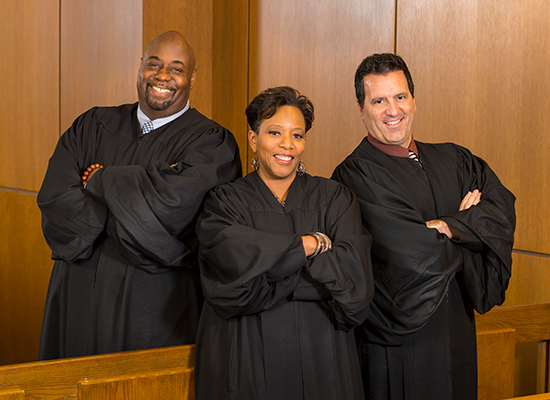
Milwaukee Municipal Court judges Derek Mosley, Valarie Hill, and Phil Chavez devised a plan to help reduce the number of people who skipped their court dates by holding walk-in Warrant Withdrawal Wednesdays at the courthouse. To increase accessibility, they then took the court out into the community.
If you have to choose between appearing in municipal court or going to work to keep your boss happy and not lose all or most of a day’s pay, many people will opt to skip their court date. Indeed, the failure-to-appear rate on arraignment at the Milwaukee Municipal Court can be as high as 70 percent.
Municipal judges Valarie Hill, Phil Chavez, and Derek Mosley devised a plan to help reduce that number. “Judge Hill was the one who pitched an idea to myself and Judge Chavez,” Mosley recalls. “She asked, ‘What if we gave everybody a fresh start?’”
Toward that end, they held three walk-in Warrant Withdrawal Wednesdays in November 2016. People came to court to take care of municipal warrants, driver’s license suspensions, or vehicle registration suspensions – with no fear of being arrested or forced to pay outstanding fines on the spot. They could talk to a judge to work out a payment plan or agree to community service or other substitute for monetary payment.
Losing a driver’s license or vehicle registration makes it difficult, even impossible, to hold a job, because many Milwaukee-area jobs are in the suburbs. With no public transit to get there, people have to drive. If they get pulled over and lack a driver’s license or vehicle registration, “the citations just keep building and building,” Mosley says. “We’re trying to give people a shot at getting to those jobs and make it easier for them to come see us.”
A total of 2,400 individuals with 15,397 cases appeared in court on those three November Wednesdays. Forty-five percent of them had never appeared in court on those cases before.
A review some months later, however, revealed that many people were back on warrant status or had again been issued license or registration suspensions. So the judicial trio came up with another idea: taking the court out into the community.
On May 24 of this year, they held a Warrantless Wednesday at the Greater New Birth Church on Milwaukee’s northwest side. For this event, 250 people preregistered, a necessity because of the limited capacity of the church.
The smaller crowd also made it possible to offer additional kinds of help. Division of Motor Vehicles staff were on hand to answer questions. Others offered job interview tips and helped prepare resumés. Several employers held interviews on site. “We actually had people leave that day with jobs,” Mosley says.
Plans now are underway to hold a future event on Milwaukee’s south side, which has a large Latino population. Those who have immigration issues have even more reason to feel reluctant to go to court. But the south-side session will have the same no-arrests policy.
Part of what enables this community outreach effort is the fact that the court is paperless, Mosley notes. “That allows me to grab my laptop and head out,” he says. “It’s a lot easier for people to walk to us right in their neighborhoods than it is for them to catch two or three buses to get downtown.”
Brian Potts: Inventing LegalBoard™
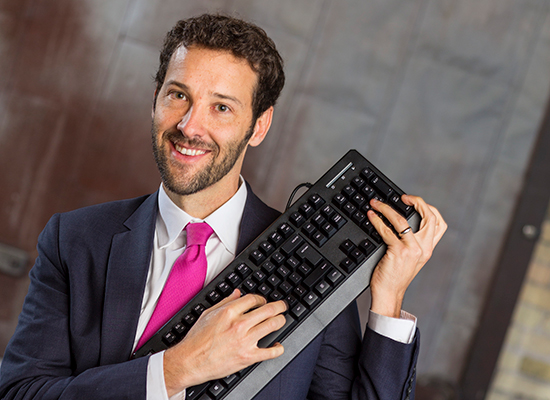
Brian Potts invented LegalBoard™, which has keys for inserting symbols, footnotes, comments, legal phrases, and more with just a quick keystroke, saving time and frustration when typing legal briefs.
No doubt you’ve had moments when you’re doing some repetitive task and you think, “There has to be an easier way. Somebody ought to make something.” Madison lawyer Brian Potts decided to be that somebody.
When he’d type legal briefs, he’d repeatedly have to insert certain symbols and phrases lawyers tend to use all the time. How could he save time and frustration? At first, he thought the answer might be to put a button on the screen within Microsoft Word.
“Then I looked down at my keyboard and thought, ‘Wait a minute,’” he recalls. “’Why not just put something on the keyboard? There are a lot of keys I don’t use.’”
The end result of his problem solving was a new keyboard called LegalBoard™ that has keys for inserting symbols, footnotes, comments, legal phrases, and so on with just a quick keystroke. The user presses the LegalBoard symbol on the keyboard to turn on the legal functions and then hits it again to revert to a normal keyboard.
It took a year from the time Potts had his idea until LegalBoard made its market debut. “I’d never done anything remotely like this before,” he says. “I’d never manufactured and sold a product, never designed packaging or a website. I’m not a computer engineer. So there were a lot of hurdles. But from a big-picture standpoint, it seemed doable.”
Friends and family members had the expertise Potts needed. A major stroke of luck was finding a company called DS International, which interfaces between U.S. companies and keyboard manufacturers in China.
“I just kept taking the next step and the next step,” Potts says, “and it sort of fell together.”
He rolled out LegalBoard at the Las Vegas Consumer Electronics Show on Jan. 5, 2017, and took preorders that day. The first shipments went out at the end of February. Potts can’t give precise sales numbers, but he says he’s “sold thousands” to lawyers in every state except Wyoming.
“We just had one of the largest law firms in the country buy 100 to test them out at six offices,” he reports. LegalBoard sells for $75.
Now Potts’ major focus is on boosting his marketing efforts. He advertises online, and a major law office supply company resells LegalBoard for him. “That’s helped,” he says, “because I don’t want to be a keyboard salesman when I grow up.”
Meanwhile, he has his day job at Perkins Coie LLP in Madison, and LegalBoard is a sideline. As for the time he has to invest in the latter, “People are amazed when I tell them it’s actually very little work now,” he says, “and has been for the last few months,” thanks, he notes, to today’s technology.
When an order comes in via his website (legalkeyboards.com), Potts’ telephone dings, and a keyboard ships out from a warehouse in Nevada. “There aren’t thousands of keyboards in my garage,” he says, “like there would have been if I’d done this 20 years ago.”
Seth Dizard and Nick DeSiato: Resolving Nuisance Properties
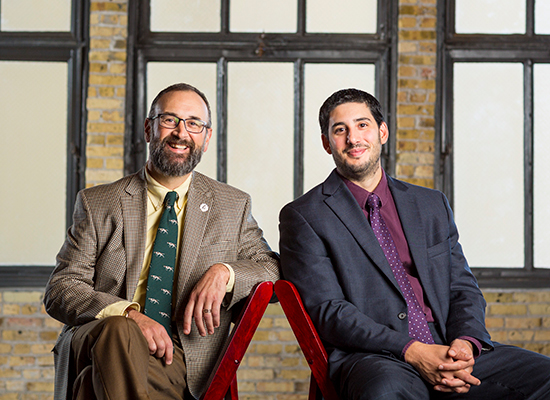
Private lawyer Seth Dizard and municipal lawyer Nick DeSiato struck on the idea of using receiverships to deal with foreclosed or nuisance properties in Milwaukee.
The Great Recession of 2008-09 left in its wake a wave of foreclosures in Milwaukee. Those properties often ended up abandoned or neglected, or slumlords bought them up in huge numbers and then let them deteriorate. “The problem was that the city had a limited bag of tricks for dealing with those properties,” says Milwaukee lawyer Seth Dizard.
For instance, the owner might pay no property taxes for a couple of years before the city could initiate a tax foreclosure proceeding, which would go on for several more months. In the meantime, the abandoned property became a magnet for drug use or other crimes. Thieves stripped away copper piping, furnaces, and anything else of value.
“Finally, the city gets the property,” Dizard explains, “and faces the awful choice of spending an inordinate amount of money to rehabilitate it or simply knock it down. It’s a vicious cycle.”
Dizard saw parallels between this situation and the problems lenders face in dealing with distressed businesses. For most of his 18 years in private practice, his work has entailed using receiverships as a solution for distressed businesses.
In the case of residential foreclosures, “I thought it’s the same set of problems,” he says. “You have a deteriorating asset and nobody is in place to oversee it and prevent additional harm.”
So Dizard struck on the idea of using receiverships to deal with foreclosed properties. He found a willing partner in Nick DeSiato in the Milwaukee City Attorney’s office. The first case they worked on together involved an after-set house – a place where people go after bar hours to keep on partying.
“There are no rules, so you have prostitution, violent activity, drug activity – a lot of bad stuff happening,” DeSiato says, “not to mention there’s music blasting at 4 a.m. in a residential neighborhood. It can be a real terror.”
Although the city can take action, which can go on for years, to try to permanently halt nuisance activity, “the question then becomes, ‘Now what?’” DeSiato says. “That’s Seth’s role: figuring out and collaborating with others on the ‘now what.’”
Since that first case, Dizard and DeSiato have worked together to resolve other nuisance properties. As a court-appointed receiver, Dizard’s job is to get control of the property. He works with others in the community to make sure the property is maintained and rented out or sold to a reputable buyer who will keep the house occupied and in good repair.
“In his role in the private sector, Seth has relationships we don’t have as a municipal government,” DeSiato says. Still, he emphasizes that Dizard is not a “yes man” to the city. “He may recommend an action we don’t support,” DeSiato says. “His fiduciary responsibility is to the court, not to us.”
Thanks to Dizard’s and DeSiato’s efforts, neighbors no longer feel threatened, and renters pay a fair price for safe, decent housing. “One of the other benefits,” Dizard adds, “is that rather than reducing our city’s rental stock, we stabilize it, even increase it. I thought it was an idea whose time had come.”
Hey Innovator, What Do You Think?
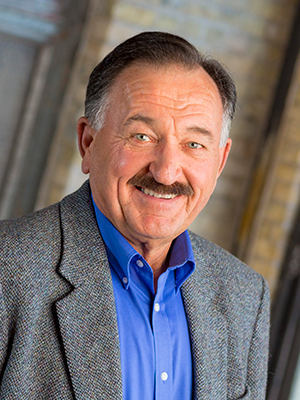 William “Byll” Hess
William “Byll” Hess
L & S Electric, Mosinee
How do you overcome resistance to change from others?
Early on, I learned that even if I had a plan for introducing new technology into the law firm, I needed to bring attorneys and staff into the process of defining the need and envisioning the use of new hardware or software to meet the need. The next step was to include the same people in planning the implementation and training process as well as preparing policies and procedures for the new technology. Finally, including the same people is also important for the ongoing evaluation and tweaking of the technology and the policies and procedures for its use.
When everyone is involved in the process from the beginning, they take ownership in the process and invest in its success and growth.
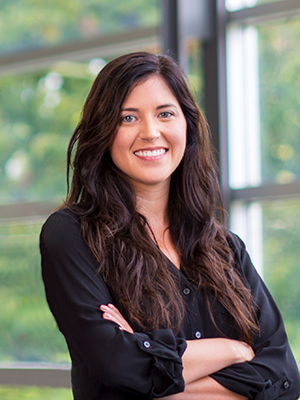 Maria de Arteaga
Maria de Arteaga
Wisconsin Innocence Project,
U.W. Law School, Madison
What motivates you to move from idea to action?
Finding motivation comes easiest for me when I am passionate about the work I am doing, and I find I am most passionate when the stakes are high. Knowing that we have the potential to drastically affect our clients’ futures drives me to take action each day.
Progress can be slow in post-conviction work, and that can make it challenging to stay motivated at times. This is where having a creative team with a shared mission is key. Not only do we each bring different experiences and ideas to the table, but we also energize each other to keep taking the small steps necessary to meet our goals and seek results.
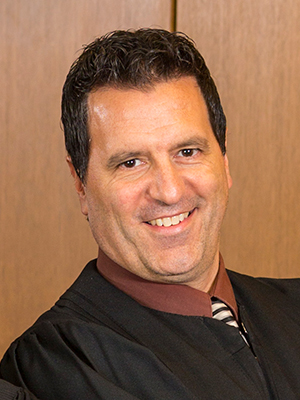 Hon. Phillip M. Chavez
Hon. Phillip M. Chavez
Milwaukee Municipal Court, Milwaukee
How do you nurture creativity in yourself and others?
Exercise helps to keep the mind active. I do a kickboxing workout at least four days per week. I try to harness that creativity in others by volunteer coaching (football and the aforementioned kickboxing). It truly opens up the mind and spirit to creative thought.
To recharge my batteries, I love spending time with my family. We all love sports so watching a great Bucks, Brewers, Badgers, or Packers game is always the ticket!
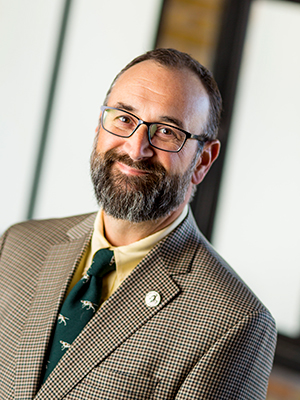 Seth E. Dizard
Seth E. Dizard
O’Neil, Cannon, Hollman, DeJong & Laing SC, Milwaukee
When do you get your best ideas?
I am an avid upland bird hunter. My favorite part of that pursuit is training and working with incredibly smart and talented hunting dogs. I own a German shorthaired pointer, and she has tons of energy. My daily routine includes two brisk walks a day – one before sunrise and one before bed.
It’s during these walks when I let my mind wander. Over the years, I’ve worked through the thorniest legal issues, and come up with ideas and potential solutions to all sorts of problems, seemingly out of the clear blue sky. Intellectually, I know experts tell us repeatedly that letting your thoughts unspool during unconstructed free time can fuel creative thinking and problem solving, but emotionally I’m always surprised when a clear, cogent, fully formed thought pops into my head when I’m out with my dog.
What I deeply enjoy about these times, when I’m walking along the same paths and sidewalks that I have followed literally thousands of times, is how they help me organize my thoughts and plans for the day ahead, and how they also let me sort through the challenges from the passing workday.
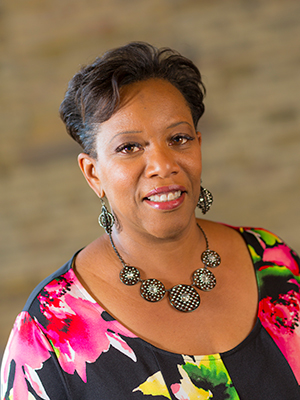 Hon. Valarie A. Hill
Hon. Valarie A. Hill
Milwaukee Municipal Court, Milwaukee
How do you recharge your batteries?
Travel is my favorite way to recharge my batteries. While I’ve traveled to a lot of places, I find that the beaches in the Caribbean or ocean side are the best places to just let everything go. Lounging on the beach is a great way to relax, release, and rejuvenate. I love the smell, sounds, beauty, tranquility, and vastness of the water, and the laid-back attitude of locals is an added bonus.
When I can’t travel, the sounds of smooth jazz and an adult beverage are an amazing way to de-stress.
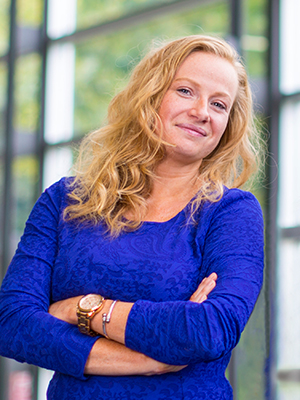 Yvonne A. Geerts
Yvonne A. Geerts
Wisconsin Innocence Project, U.W. Law School, Madison
Where or when do you get your best ideas? How do you nurture creativity?
Mind Maps, only sort of kidding. I find that my best ideas come from doing something almost meditative like long bicycle rides or when I sit still, close my eyes, and listen to vinyl record albums from start to finish, and through a willingness to follow the complicated path of even far-fetched ideas. Even if the path doesn’t lead you somewhere concrete, the process can teach you something. I delight in exploring possibility.
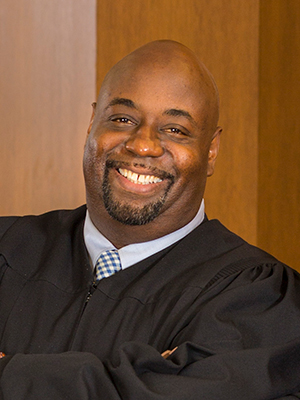 Hon. Derek C. Mosley
Hon. Derek C. Mosley
Milwaukee Municipal Court, Milwaukee
How do you recharge your batteries?
I thought my wife was a little bit out of her mind early in our marriage when she first suggested that we go camping. Black men from the South Side of Chicago don’t camp – we don’t even Glamp! But now I find that camping is my favorite way to recharge my batteries. There is nothing on earth like sitting around the campfire with my family, telling ghost stories, eating marshmallows, and forgetting about the cares of the world.
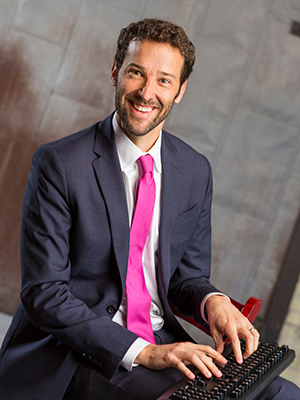 Brian H. Potts
Brian H. Potts
Perkins Coie LLP, Madison
What motivates you to move from idea to action?
I’m always looking for ways to make life better and to have as much fun as possible while doing so. And I have a restless mind, so I’m always thinking about things I could do that would be fun and cool professionally and personally. Then, when I settle on what I think is a good idea, I often can’t stop thinking about it and focusing on it until I take action.
Given all the things I’m juggling professionally and personally, people always ask me if I sleep. And, oddly, the answer is that I sleep a lot. It’s just that during the day, I’ve never been able to sit still. So doing things has always come relatively easy for me. And I get a lot of satisfaction from completing projects, which is a great motivator.
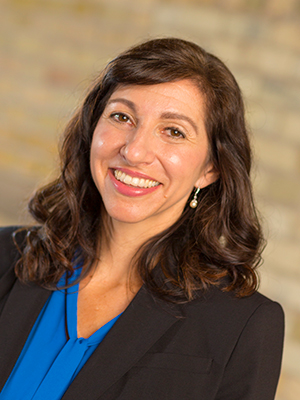 Cristina Bordé
Cristina Bordé
Wisconsin Innocence Project, U.W. Law School, Madison
What inspired you to develop the Wisconsin Latino Exoneration Program?
The idea came to me when I saw an unmet need. My decades of experience working with Latino clients in the death penalty context has given me insight into the particular problems that arise in such cases.
When I started working on innocence cases, I realized that we have yet to understand how cultural, linguistic, and immigration barriers can affect a Latino defendant’s ability to prove his or her innocence. We developed our program to help Latino defendants overcome these barriers and provide them with excellent legal representation to prove their innocence.
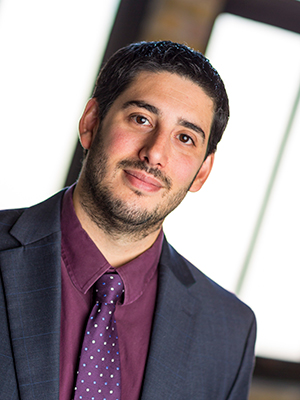 Nicholas P. DeSiato
Nicholas P. DeSiato
Milwaukee City Attorney’s Office, Milwaukee
What motivates you to move from idea to action?
I’m from Philly. We’re scrappy and have a chip on our shoulder from a generation of failed sports teams. If someone doubts that the next “great idea” I’m working on will ever come to fruition, I get even more fired up to make it happen.
Honestly, I love to work. I love to see words turn into action. And I am obsessed with working toward making good ideas with good people happen, particularly when those good ideas positively contribute to this great city. Under Grant Langley, our city attorney, our unit has the support to think outside the box and be a proactive part of the solution.
